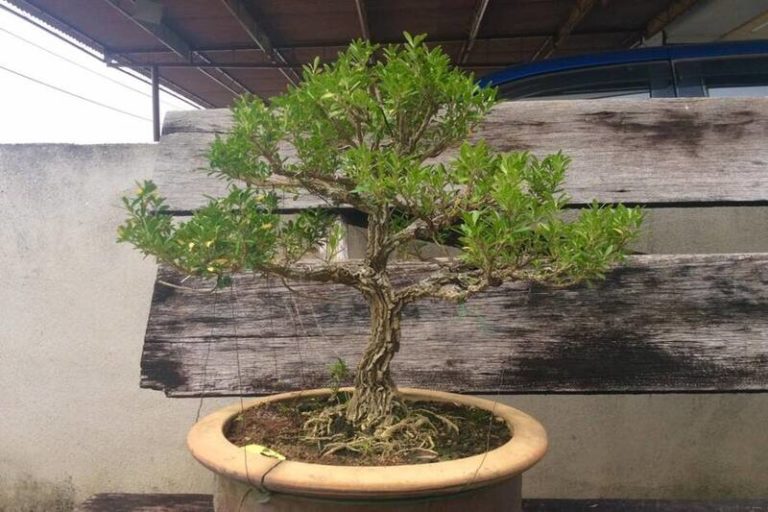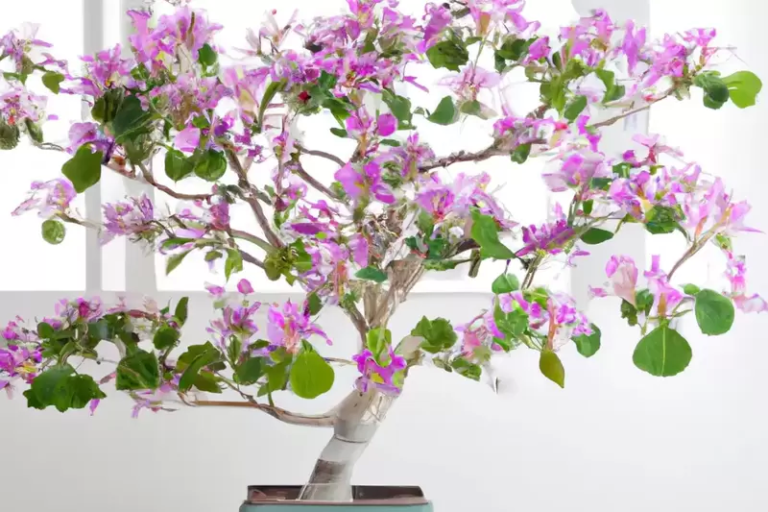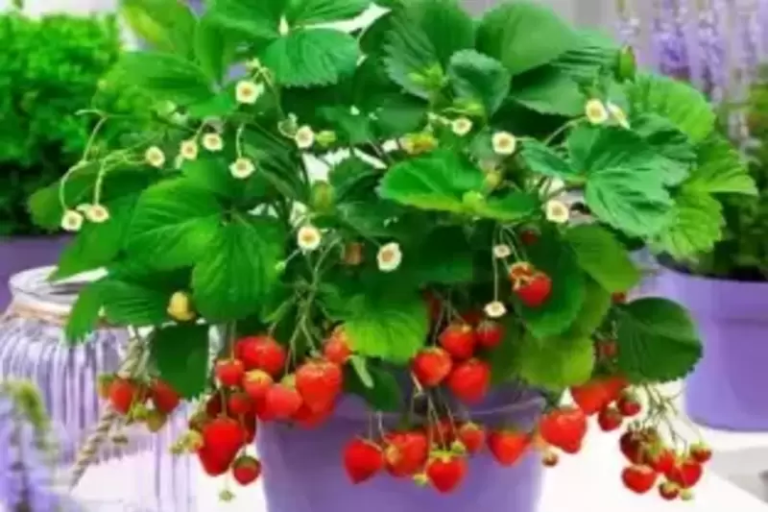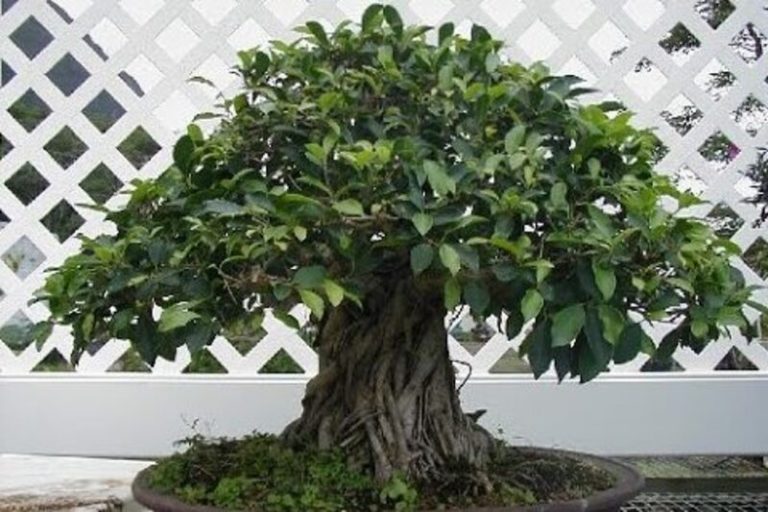Burning Bush Bonsai: Bringing Nature’s Fiery Charm to Your Home
Bonsai trees are small copies of trees that are meticulously nurtured and molded to produce a gorgeous and one-of-a-kind exhibit. The flaming bush bonsai is a popular bonsai species. In this post, we will look at what makes the burning bush bonsai unique and present a step-by-step method to assist beginners develop and care for their own.
What is Burning Bush Bonsai?
Burning bush bonsai is the art of growing a miniature version of the burning bush (Euonymus alatus) tree as a bonsai. It involves carefully shaping and training the tree to create a smaller version that captures its beauty. The burning bush is known for its vibrant red foliage during autumn, which makes it a popular choice for bonsai enthusiasts. Cultivating a burning bush bonsai requires specific techniques such as selecting the right specimen, providing proper soil and potting, regular pruning and shaping, and ensuring appropriate watering and sunlight. With proper care, the burning bush bonsai can be a captivating and visually appealing addition to any space.
History and Origins of the Burning Bush Bonsai
Bonsai is an old Chinese art form that has been practiced for over a thousand years, and the history and origins of the flaming bush bonsai may be traced back to this time. Bonsai, literally “tray planting,” is the art of cultivating and training trees in small pots to mimic the proportions, shape, and symmetry of their natural surroundings.
The blazing bush bonsai is made up of Euonymus alatus, often known as the burning bush or flying euonymus. This deciduous shrub is indigenous to eastern Asia, including China, Japan, and Korea. The blazing bush may develop into a big shrub or small tree in its native habitat, reaching heights of up to 20 feet (6 meters). The flaming bush is distinguished by its unusual winged stems, rich green foliage throughout the growth season, and a spectacular display of bright red leaves in fall.
The technique of maintaining the flaming bush as a bonsai tree arose as part of the larger bonsai tradition in East Asia. Bonsai originated in China and moved to Japan, where it blossomed and became firmly ingrained in Japanese culture. Japanese bonsai masters advanced bonsai methods and aesthetics, including the cultivation of numerous tree species such as the flaming bush.
The flaming bush bonsai acquired popularity not just in Japan, but also in other regions of the world throughout time. The distinctive beauty and aesthetic potential of the blazing bush were recognized by bonsai aficionados worldwide, and it became a sought-after species for bonsai culture.
The flaming bush bonsai is still a popular and beloved type among bonsai enthusiasts today. Its eye-catching crimson foliage, slender branches, and complicated design make it an ideal choice for creating enthralling miniature landscapes. The history and roots of the burning bush bonsai are connected with the rich bonsai legacy, displaying the creativity, patience, and respect for nature that define this ancient craft.
Burning Bush Bonsai and Their Symbolism
Burning bush bonsai not only possess aesthetic appeal but also carry symbolic meaning in various cultural and spiritual contexts. Here are some of the symbolic interpretations associated with burning bush bonsai:
- Transformation: The burning bush bonsai, with its vibrant red foliage during autumn, symbolizes transformation and change. Just as the burning bush sheds its green leaves and adorns itself with fiery red hues, it represents the cycle of growth, transition, and renewal. It serves as a reminder that change is a natural and beautiful part of life.
- Resilience: The burning bush bonsai is known for its hardiness and ability to withstand harsh conditions. It symbolizes resilience and perseverance in the face of adversity. This quality can inspire individuals to overcome challenges and thrive, much like the burning bush that endures and flourishes.
- Spiritual Awakening: In some spiritual traditions, the burning bush is associated with spiritual enlightenment and awakening. It represents the moment when one’s inner self is illuminated and a deeper understanding is attained. The burning bush bonsai can serve as a reminder to seek spiritual growth and introspection.
- Balance and Harmony: In general, bonsai represents the notion of balance and harmony between nature and human intervention. The neatly clipped and formed form of the flaming bush bonsai reflects the peaceful cohabitation of the bonsai artist’s vision and the innate beauty of the tree. It represents the delicate balance we strive for in our lives, as well as our connection to the natural world.
- Beauty in Simplicity: The art of bonsai celebrates simplicity and minimalism. The burning bush bonsai, with its small size and elegantly arranged branches, embodies the beauty that can be found in simplicity. It encourages us to appreciate the little things in life and find joy in the understated.
While these symbolic interpretations can vary across cultures and personal beliefs, the burning bush bonsai undeniably carries a sense of beauty, transformation, resilience, and balance. Its presence can inspire contemplation and reflection, reminding us of the deeper meanings and connections present in the natural world.
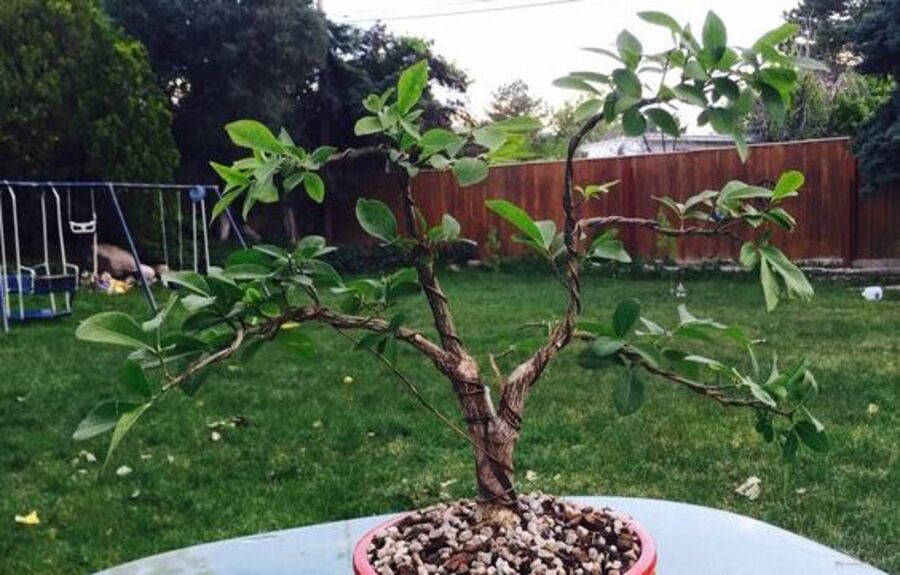
Characteristics of the Burning Bush Bonsai
The flaming bush bonsai (Euonymus alatus) has various distinguishing features that make it a popular option among bonsai aficionados. The following are some distinguishing characteristics of the flaming bush bonsai:
Foliage: The burning bush bonsai is known for its foliage, which undergoes a stunning transformation throughout the seasons. During spring and summer, the leaves are a vibrant green, providing a lush and fresh appearance to the bonsai. As autumn approaches, the foliage transitions into brilliant shades of red, creating a captivating display of color.
Winged Stems: One of the most unique features of the burning bush bonsai is its winged stems. The branches of the burning bush have corky protrusions, often referred to as wings or ridges, which add visual interest and texture to the bonsai’s overall appearance.
Deciduous Nature: Like its larger counterpart, the burning bush bonsai is a deciduous plant. It sheds its leaves during the winter months, allowing for an intriguing display of bare branches. This characteristic provides bonsai enthusiasts with the opportunity to appreciate the bonsai’s elegant branch structure and create visually striking designs during the tree’s dormant phase.
Size and Form: The burning bush bonsai is often modest in size, reflecting the desire for bonsai plants to be miniaturized. Because of its tiny size, it may be readily cultivated and presented in a number of settings, both inside and outdoors. Bonsai lovers may produce distinctive and visually beautiful shapes and styles, such as the formal upright or the cascade, by meticulous pruning and training.
Adaptability: The burning bush bonsai is known for its adaptability to different growing conditions. It can tolerate a range of soil types and thrive in both full sun and partial shade. This adaptability makes it suitable for a variety of climates and allows bonsai enthusiasts with diverse environments to enjoy growing and caring for this species.
Ornamental Value: Beyond its characteristics as a bonsai, the burning bush is valued for its ornamental qualities in landscaping. The vibrant red foliage during autumn makes it a popular choice for adding a splash of color to gardens and landscapes.
Overall, the burning bush bonsai combines unique foliage, distinctive winged stems, adaptability, and ornamental value, making it an appealing choice for bonsai enthusiasts. Its transformation throughout the seasons and its ability to adapt to different growing conditions contribute to its allure as a captivating and visually striking bonsai specimen.
Types of Burning Bush Bonsai
There are no specific “types” of burning bush bonsai, as the term generally refers to the bonsai cultivation of the Euonymus alatus species. However, within the realm of burning bush bonsai, there can be variations in terms of styling and design. Here are some common styles and variations you may encounter when it comes to burning bush bonsai:
1. Formal Upright: This style features a straight and upright trunk with branches gradually tapering upwards. The foliage is evenly distributed, and the overall form of the bonsai resembles that of a mature tree.
2. Informal Upright: In this style, the trunk exhibits a slight curve or bend, giving the bonsai a more natural and organic appearance. The branches may have a more relaxed and irregular structure.
3. Cascade: The cascade style mimics the appearance of a tree growing on a steep slope or cliff. The trunk cascades downward, often extending below the base of the pot. The branches and foliage follow the flow of the cascade, creating a dramatic and dynamic composition.
4. Windswept: This style portrays the effect of strong winds on the tree, with the trunk and branches bending and curving in one direction. The foliage may be concentrated on one side of the tree, further emphasizing its windswept appearance.
5. Group Planting: This method, also known as “forest planting” or “yose-ue,” involves putting several burning bush bonsai plants in a single pot. The trees are grouped to resemble a tiny forest, producing harmony and oneness.
It is crucial to highlight that the style and design of a bonsai tree, especially burning bush bonsai, are ultimately determined by the bonsai artist’s vision and expertise. Bonsai aficionados may develop their own unique interpretations and variants within the flaming bush bonsai genre by using correct pruning, wiring, and training procedures.
How to Grow a Burning Bush Bonsai
Growing a bonsai burning bush may be a rewarding and pleasurable activity. Here’s how to develop a flaming bush bonsai step by step:
Obtaining a Specimen:
Look for a young burning bush tree (Euonymus alatus) with a well-developed root system. Consider purchasing a pre-bonsai or nursery-grown specimen.
Selecting the Right Pot and Soil:
Choose a bonsai pot that allows for proper drainage and has enough space for the roots to grow.
Use well-draining bonsai soil or create a mixture of akadama, pumice, and lava rock to provide adequate aeration and moisture retention.
Pruning and shaping:
Start by pruning away any dead, damaged, or unwanted branches to establish the basic structure.
Use bonsai wire to gently shape the branches, guiding them into the desired form. Be careful not to apply excessive force that could damage the branches.
Watering:
Water the burning bush bonsai thoroughly whenever the soil starts to dry out. Ensure that the water reaches the entire root system.
Avoid overwatering, as it can lead to root rot. Allow the top layer of soil to dry slightly between watering.
Sunlight and Temperature:
Place the burning bush bonsai in a location that receives full or partial sunlight. It prefers at least 4-6 hours of direct sunlight per day.
Protect the bonsai from extreme temperatures. During the winter, provide some frost protection if necessary.
Fertilizing:
Apply a balanced liquid fertilizer during the growing season, following the manufacturer’s instructions. This helps provide essential nutrients for healthy growth.
Reduce or stop fertilizing during the dormant period in the winter.
Repotting:
Repot the burning bush bonsai every two to three years, typically in early spring before new growth starts.
Trim back the roots and remove any circling or compacted roots. Repot in fresh bonsai soil, ensuring proper drainage.
Pest and Disease Management:
Regularly inspect the bonsai for pests such as aphids or spider mites. Treat any infestations promptly using appropriate insecticides or natural remedies.
Watch for signs of diseases like powdery mildew or root rot. Adjust watering and improve air circulation if necessary.
Maintenance:
Continuously shape the bonsai to maintain the desired form.
Patience and Care:
Growing a burning bush bonsai takes time and patience. Regularly observe and care for your bonsai, adjusting techniques as needed. Enjoy the process and the beauty that your burning bush bonsai brings to your space.
Remember, growing a burning bush bonsai is a continuous learning experience. Experiment, observe, and adapt your techniques to meet the unique needs of your bonsai tree. With proper care and attention, your burning bush bonsai can thrive and become a captivating addition to your bonsai collection.
Benefits of the Burning Bush Bonsai
The burning bush bonsai (Euonymus alatus) offers several benefits to bonsai enthusiasts and those who appreciate its beauty. Here are some of the key benefits of growing a burning bush bonsai:
- Aesthetic Appeal: The burning bush bonsai is admired for its striking visual appeal. The vibrant red foliage during autumn creates a captivating display of color, making it a focal point in any setting. Its delicate branches and unique winged stems add interesting texture and form to the bonsai.
- Miniaturized Beauty: Growing a burning bush bonsai allows you to appreciate the beauty of a full-sized burning bush tree in miniature form. It provides the opportunity to create a living work of art that showcases the elegance and grace of nature at a compact and manageable size.
- Seasonal Interest: The burning bush bonsai offers seasonal interest throughout the year. During spring and summer, it displays lush green foliage, adding freshness to the surroundings. As autumn arrives, the leaves transform into a vibrant red, creating a captivating spectacle that celebrates the changing seasons.
- Bonsai Training and Artistry: Cultivating a burning bush bonsai allows bonsai enthusiasts to engage in the art of bonsai training and shaping. Pruning, wiring, and shaping the bonsai tree provide an outlet for creativity and self-expression. The burning bush’s unique characteristics, such as its winged stems, lend themselves well to various bonsai styling techniques.
- Educational and Therapeutic Value: Growing and caring for a bonsai burning bush may be a rewarding and relaxing endeavor. It provides an opportunity to learn about horticulture, plant maintenance, and the bonsai art form. Plant work and connecting with nature have been found to relieve stress, boost attention, and generate a sense of well-being.
- Versatility and Adaptability: The adaptability of the burning bush bonsai to varied growth environments is well recognized. It can be cultivated both indoors and outdoors, making it suited for a wide range of settings and temperatures. Its toughness and ability to tolerate pruning and shaping make it an excellent option for bonsai aficionados of all skill levels.
- Symbolism and Meaning: The burning bush bonsai carries symbolic meanings associated with transformation, resilience, and harmony. It can serve as a reminder of the beauty of change and the need to adapt and grow. Its presence can evoke a sense of tranquility and contemplation, adding a deeper dimension to its value.
Overall, the burning bush bonsai offers aesthetic beauty, educational value, artistic expression, and a connection to nature. It can be a source of joy, inspiration, and personal growth as you nurture and care for this living masterpiece.

Displaying and Showcasing the Burning Bush Bonsai
Displaying and showcasing your burning bush bonsai (Euonymus alatus) can enhance its beauty and create a visually appealing focal point in your home, garden, or bonsai exhibition. Here are some tips for displaying and showcasing your burning bush bonsai:
1. Choice of Display Area: Select a suitable location that meets the light and environmental requirements of your burning bush bonsai. It should receive adequate sunlight or partial shade, depending on the specific needs of your bonsai tree. Avoid extreme temperature conditions or drafts that may adversely affect its health.
2. Bonsai Stand or Table: To raise your fire bush bonsai and give a visually appealing backdrop, place it on a bonsai stand or a solid table. The stand can be built of wood, stone, or other materials that compliment your bonsai’s beauty.
3. Consider the Background: Choose a background that enhances the visual impact of your bonsai. A neutral-colored wall, a simple backdrop, or a backdrop with natural elements like rocks or moss can provide a harmonious setting for your burning bush bonsai to shine.
4. Rotation: Regularly rotate your bonsai to ensure even growth and balanced exposure to sunlight. This helps prevent the tree from leaning or growing more prominently in one direction. Rotating the bonsai also allows viewers to appreciate the tree from different angles.
5. Accent Plants and Decorative Elements: Consider adding accent plants, such as moss, small flowers, or ground cover plants, around the base of your burning bush bonsai to create a more natural and visually appealing composition. Additionally, you can incorporate decorative elements like small figurines, stones, or bonsai display accessories that complement the style and theme of your bonsai.
6. Bonsai Display Tables or Shelves: You may exhibit many bonsai trees, including your burning bush bonsai, on a specialized bonsai display table or shelf. To make an aesthetically beautiful exhibit, arrange the trees in a harmonic and balanced manner, taking into account their sizes, shapes, and colors.
7. Bonsai Exhibition: Participate in bonsai exhibitions or shows to showcase your burning bush bonsai to a wider audience. Such events provide a platform to share your passion and knowledge with fellow bonsai enthusiasts. Ensure proper transportation and care for your bonsai when taking it to exhibitions, following the guidelines and requirements of the event organizers.
8. Photography: Photograph your flaming bush bonsai to capture its beauty. Take high-quality images from various angles, emphasizing its distinct traits and seasonal variations. To chronicle the growth and progression of your bonsai tree, share your images online or build a bonsai photo album.
Remember to regularly care for and maintain your burning bush bonsai, ensuring its health and aesthetics. Proper watering, pruning, and attention to detail will keep your bonsai in optimal condition, ready to be showcased and admired by others.
Styling and Design of a Burning Bush Bonsai
When it comes to styling and designing a burning bush bonsai (Euonymus alatus), there are various approaches and techniques you can utilize to create a visually appealing and harmonious composition. Here are some styling and design considerations for your burning bush bonsai:
Trunk and Branch Structure: Evaluate the trunk and branches of your burning bush bonsai to determine the desired style. You can aim for a formal upright style with a straight, vertical trunk or explore more dynamic styles like slanting, windswept, or cascading. Consider the natural growth patterns of the burning bush and work with its unique characteristics, such as the winged stems, to create an interesting and balanced branch structure.
Branch Placement and Direction: Arrange the branches of your burning bush bonsai to create a sense of balance and harmony. Avoid overcrowding or crossing branches, as they can detract from the overall design. Maintain an open and airy structure by allowing space between branches, ensuring each one has room to develop and receive adequate light.
Pruning and Defoliation: Prune your burning bush bonsai regularly to maintain its shape and encourage compact growth. Use sharp bonsai tools to remove excess foliage, unwanted shoots, and any branches that disrupt the desired design. Defoliation, the temporary removal of leaves, can be employed during the growing season to promote finer twigging and encourage back-budding.
Wiring and Shaping: Wiring is a fundamental technique in bonsai styling. Use bonsai wire to gently guide the branches into the desired position. Take care not to damage the branches or bark while wiring. The winged stems of the burning bush can provide interesting contours and twists that can be emphasized or controlled through wiring.
Repotting and Root Pruning: Repot your burning bush bonsai every few years to maintain its health and encourage vigorous growth. During repotting, trim the roots to prevent them from becoming too long or tangling. This process also provides an opportunity to adjust the planting angle or position of the bonsai in the pot, enhancing the overall design.
Seasonal Considerations: Embrace the natural changes in foliage color and texture throughout the seasons. The vibrant red leaves of the burning bush during autumn are a highlight, but the tree also offers attractive green foliage during spring and summer. Consider how the changing seasons can complement and enhance the overall aesthetic of your bonsai.
Balance and Proportion: Aim for balance and proportion in your burning bush bonsai’s general design. Make sure there isn’t too much or uneven growth in one area, and make sure the leaves and stems are spread out evenly. Consider the size of the pot, the height of the tree, and the thickness of the branches to create a beautiful arrangement.
Don’t forget that creating a burning bush bonsai is an ongoing artistic process. It needs close attention, regular upkeep, and a lot of time. As you work on and improve your bonsai over time, it will grow into a unique and interesting tiny version of the burning bush.
How to Care for and Maintain a Burning Bush Bonsai
Caring for and maintaining a burning bush bonsai (Euonymus alatus) is essential to ensuring its health, vitality, and long-term beauty. Here are some guidelines to help you care for and maintain your burning bush bonsai:
Watering:
- Check the moisture level of the soil regularly, and water when the top inch feels slightly dry. Avoid overwatering, as it can lead to root rot.
- Water thoroughly, ensuring that the water reaches the entire root system. Allow the excess water to drain out of the pot.
Sunlight and Temperature:
- Place your burning bush bonsai in a location that receives full to partial sunlight. It prefers at least 4-6 hours of direct sunlight per day.
- Protect the bonsai from extreme temperatures. During hot summers, provide shade or move the bonsai to a cooler location. Provide frost protection during the winter if necessary.
Fertilizing:
- Feed your burning bush bonsai with a balanced, slow-release bonsai fertilizer during the growing season (spring to autumn).
- Follow the instructions on the fertilizer package for the appropriate dosage.
- Reduce or stop fertilizing during the dormant period in the winter.
Pruning and Shaping:
- Regularly prune your burning bush bonsai to maintain its shape and encourage compact growth. Remove any dead, diseased, or unwanted branches.
- Use bonsai wire to gently shape the branches, guiding them into the desired form. Be careful not to apply excessive force that could damage the branches.
Repotting:
- Repot your burning bush bonsai every two to three years, typically in early spring before new growth starts.
- Trim back the roots, removing any circling or compacted roots. Repot in fresh bonsai soil, ensuring proper drainage.
- Consider adjusting the planting angle or position of the bonsai in the pot to enhance its aesthetic appeal.
Pest and Disease Control:
- Regularly inspect your burning bush bonsai for pests such as aphids, spider mites, or scale insects. Treat any infestations promptly using appropriate insecticides or natural remedies.
- Watch for signs of diseases like powdery mildew or root rot. Adjust watering and improve air circulation if necessary.
Leaf Maintenance:
- Remove any yellowing or dead leaves from your burning bush bonsai. This helps maintain its overall appearance and prevents the spread of diseases.
Winter Care:
- During the winter, protect your burning bush bonsai from freezing temperatures by moving it indoors or providing frost protection. Place it in a cool, well-lit area away from drafts.
- Reduce watering during the dormant period, allowing the soil to dry out slightly between waterings.
Observing and Adjusting:
- Regularly observe your burning bush bonsai for signs of stress, such as wilting or discoloration. Adjust your care routine as needed, including watering frequency, sunlight exposure, and fertilization.
Patience and Dedication:
- Growing and maintaining a burning bush bonsai requires patience and dedication. Regularly care for your bonsai, enjoy the process, and appreciate the beauty it brings to your space.
You can maintain the health and vitality of your burning bush bonsai by providing the necessary care and attention, allowing it to grow and continue to display its natural beauty for many years.
Burning Bush Bonsai Care Sheet
| Aspect | Care Tips |
| Watering | Check soil moisture regularly; water when slightly dry |
| Avoid overwatering; ensure proper drainage | |
| Sunlight | Place in full to partial sunlight (4-6 hours per day) |
| Provide shade during hot summers if needed | |
| Temperature | Protect from extreme temperatures and frost |
| Move indoors or provide frost protection in winter | |
| Humidity | Moderate humidity levels preferred |
| Mist foliage occasionally to increase humidity | |
| Fertilization | Use balanced, slow-release bonsai fertilizer |
| Apply during the growing season (spring to autumn) | |
| Pruning and Trimming | Regularly prune for shape and compact growth |
| Remove dead, diseased, or unwanted branches | |
| Wiring and Styling | Use bonsai wire to gently shape branches |
| Be cautious not to damage branches or bark | |
| Repotting | Repot every 2-3 years in early spring |
| Trim roots, adjust planting angle, and use fresh soil | |
| Pest and Disease Control | Regularly inspect for pests and diseases |
| Treat infestations promptly with appropriate measures | |
| Winter Care | Protect from freezing temperatures and drafts |
| Move indoors or provide frost protection | |
| Regular Maintenance | Remove yellowing or dead leaves |
| Adjust care routine based on observation and needs |
Remember that caring for a burning bush bonsai requires attention and observation. Tailor your care routine based on the specific needs of your bonsai, ensuring its health and beauty for years to come.
Conclusion:
Growing a burning bush bonsai can be a rewarding experience, bringing nature’s beauty into your living space. By following the simple steps outlined in this guide, beginners can successfully cultivate and care for their own burning bush bonsai.
Remember to choose a healthy specimen, provide the right soil and pot, and maintain proper watering, pruning, and fertilizing practices. Regularly inspect your bonsai for pests and diseases, and address any issues promptly.
Display your burning bush bonsai in a suitable location, and consider participating in bonsai exhibitions to showcase your creation. With patience, dedication, and a little bit of creativity, you can enjoy the beauty and tranquility of your very own burning bush bonsai. Happy bonsai gardening!
FAQ
Q: What is a burning bush bonsai?
A: A burning bush bonsai, scientifically known as Euonymus alatus, is a miniature version of the burning bush tree. It is cultivated and trained as a bonsai, showcasing the tree’s unique winged stems and vibrant foliage.
Q: Can I keep a burning bush bonsai indoors?
A: While burning bush bonsai may be kept indoors for limited periods of time, they prefer to remain outside. They need plenty of sunshine and ventilation to grow. During the growth season, it is essential to provide them with an outside environment, such as a patio or garden.
Q: How often should I water my burning bush bonsai?
A: Watering frequency is determined by a variety of elements like as climate, temperature, pot size, and soil drainage. Check the moisture level of the soil on a regular basis and water when the top inch seems somewhat dry. Overwatering can cause root rot, so avoid it. To avoid waterlogging, provide sufficient drainage.
Q: How do I prune a burning bush bonsai?
A: Pruning is an essential part of bonsai care. To prune your burning bush bonsai, use sharp bonsai tools to remove any dead, diseased, or unwanted branches. Trim back excessive growth to maintain the desired shape and size. Regular pruning will help maintain the bonsai’s form and encourage compact growth.
Q: When should I fertilize my burning bush bonsai?
A: Fertilize your burning bush bonsai during the growing season, which typically starts in spring and lasts until autumn. Use a balanced, slow-release bonsai fertilizer, following the instructions on the package for the appropriate dosage. Reduce or stop fertilizing during the dormant period in the winter.
Q: Can I wire the branches of my burning bush bonsai?
A: Yes, you can wire the branches of your burning bush bonsai to shape and style them. However, take care not to apply excessive force that could damage the branches or bark. Use bonsai wire and gently guide the branches into the desired position. Remove the wire promptly once the branches have set in the desired shape.
Q: How often should I repot my burning bush bonsai?
A: Repot your burning bush bonsai every two to three years, typically in early spring before new growth begins. During repotting, trim back the roots to prevent them from becoming too long or tangling. Repotting allows for fresh soil, improved drainage, and the opportunity to adjust the planting angle or position of the bonsai in the pot.
Q: How do I protect my burning bush bonsai during the winter?
A: Burning bush bonsai should be protected from freezing temperatures and harsh winter conditions. Move them indoors to a cool, well-lit area away from drafts, or provide frost protection by covering the bonsai with a protective material or placing it in a sheltered location. Reduce watering during the dormant period, allowing the soil to dry out slightly between watering.
Q: Are burning bush bonsai prone to pests and diseases?
A: Like any plant, burning bush bonsai can be susceptible to pests and diseases. Common pests include aphids, spider mites, and scale insects. Regularly inspect your bonsai for signs of infestation, and promptly treat any problems with appropriate insecticides or natural remedies. Watch for diseases such as powdery mildew or root rot and take the necessary measures to address them.
Q: How can I maintain the beauty of my burning bush bonsai?
A: Regular maintenance is crucial for the health and beauty of your burning bush bonsai. This includes proper watering, pruning, fertilizing, and protecting it during extreme weather conditions. Additionally, regularly check the foliage for any signs of yellowing, disease, or pest infestation. Remove any dead or discolored leaves promptly. Pay attention to the overall shape and structure of the bonsai and adjust wiring or trimming as needed to maintain its desired form. Finally, take time to appreciate and enjoy the beauty of your burning bush bonsai, as your care and dedication will be reflected in its appearance.
Also Read:



